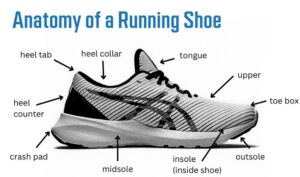Visit
Physiosports Brighton,
429 Nepean Highway, Brighton East,
3187, VIC, Australia
Call
Fax
03 9596 9155
physiosports@physiosports.com.au

In short, one size does not fit all. Rather than deciding if a shoe is good or bad, let’s try and think of what is going to suit you! First, let’s talk about what makes a shoe.

Heel Counter
Located at the back of the shoes, this structure typically wraps around the heel with a sturdy plastic. This feature is important for ankle stability, an easy test is to try and push it down with your thumb and if strong is suitable.
Upper
This is referring to the material which cover the foot, in runners it is the mesh. Mesh is thin and breathable for exercise but can lack durability. Leather uppers are more durable but not breathable. For waterproof runners or trail shoes consider Gortex (GTX) lined uppers.
Outsole
The outsole martial is what determines the traction and grip of a shoe with the ground. Different activities require different outsoles, for example trail runners are built with denser rubber outsoles and grooves.
Midsole
This is the main bulk of any shoe, for runners it is a shock absorbing foam for high impact with runner or sport. The type of foam and density matters, for larger people you may want to consider a thicker sole or denser foam more resistant to compression.
Supportive vs. Neutral Runners
Shoe Comfort
Fit
Refer to our handy flowchart when considering your next shoe purchase, this will help guide your decision-making process. If you have concerns, pain or would like to explore what the right shoe is for in more depth please book in with one of our expert Podiatrists! Physiosports Brighton stocks ranges of Asics, Nike and Mizuno collections which you may trial in clinic, this is accompanied by a thorough biomechanical assessment to find the right shoe for you. For any questions or to book please do not hesitate to contact the clinic.